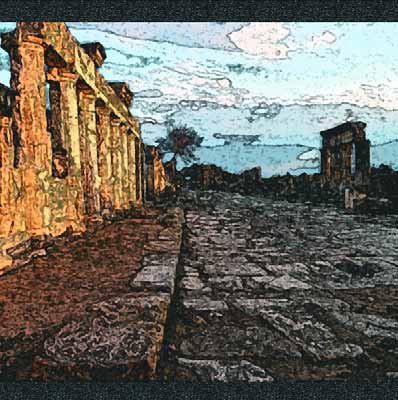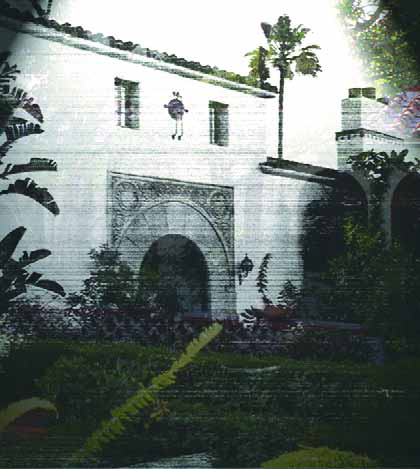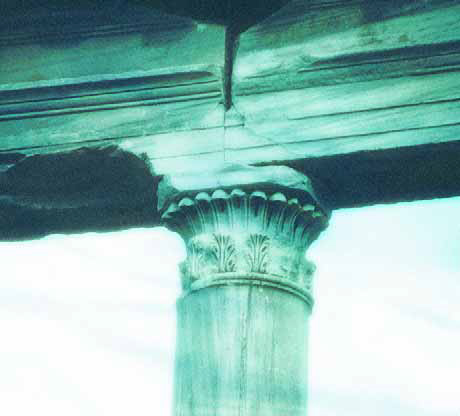Travelogues & History
For the typical visitor, the newly-reopened Getty Villa is perhaps the most exquisite of all possible venues for viewing ancient works of art and craft - reason enough to plan a visit. For students of architecture and design, however, there's much more, particularly the opportunity to immerse yourself in the living, breathing environment of a classic Roman villa and its abundant amenities. The Getty Villa site encompasses 64 acres of a rugged canyon rising above the Pacific Ocean in Malibu, Calif., and was once home to oil tycoon J. Paul Getty. A fanatical collector of Greco-Roman antiquities, he dedicated part of his original ranch-style home as a public museum in 1954. By 1974, less than a year before his death, he had completed and opened the original Villa on another part of the estate, realizing his ambition of creating a public monument dedicated to the arts. The Villa's layout was inspired by the Villa dei Papiri, a first-century country house in Pompeii buried by the eruption of Mt. Vesuvius in 79 A.D. It was Getty's vision to display his collection in a setting evocative of its contents' historic origins and he realized it, but there were compromises: The spaces were crowded, and the works on display also included samples of paintings and craftworks of much more recent vintage - Renaissance masters, baroque furnishings and other distinctly non-classical artworks. The Villa closed in 1997 at about the same time the
It's a point I'll probably make to the end of my days: There is no substitute for travel and exploration of the historic world to learn about design. In my "Details" column in the June 2005 issue of WaterShapes, for example, I discussed my recent trip to Turkey and made the point that the ruins and intact structures we examined while there were full of specific details that I and other watershapers use in our work - whether or not we recognize that what we're doing actually derives from ancient original works. Showing what I mean in the clearest possible terms is what this pictorial article is all about. As you will see, I've included
It's a truism that almost all contemporary works of art are derivative: The ideas have already been expressed in one way or another at some point in history, and all we can succeed in doing is to apply those enduring forms as creatively as we can. We can't invent the wheel, but we can redraw it, embellish it, place it in context and, in our own ways, improve upon it through the choices we make in using it. To be effective in that sort of downstream effort as watershapers, it is essential that we understand the nature and origins of the basic building blocks of aquatic design. For years, people have asked me where I get my ideas - pools raised out of the ground, the small spillways, the drain details, the modular deck treatments, the color usage and the use of reflection, to name just a few. "Through my design education" is the short answer, of course, but I can get more specific if we
Local historians claim that the image of Philadelphia's Fairmount Water Works was the most reproduced of any industrial site in the United States through the first half of the 19th Century - and for good reason. At that time, the facility represented the absolute state of the art and served as a major point of pride for local residents as well as a source of fascination to visitors from near and far. Throughout its long history, the facility was indeed at the leading edge of water-delivery technology and is now the ideal place to capture and tell the story of the development of environmentalism in the 19th and 20th centuries. The story begins
Here in America, our idea of history goes back only so far. That's particularly true in southern California, where "older" architecture is anything before about 1960 and very few structures date to a time before 1920. But it's also the case for most of the rest of the country with reference to architecture: We don't have the "ancient" structures that still set the tone and architectural vocabulary the way they do in Europe, Asia and other places. For those who prefer modern or contemporary styles, this lack of history may be irrelevant. For those who feel an affinity to older styles, however, there's a tendency to cringe every time an older house is torn down to
Since the dawn of civilization, it has stood as the single most enduring of all artistic media: From representations of mythological characters and historic events to applications as purely architectural forms and fixtures, carved stone has been with us every step of the way. As modern observers, we treasure this heritage in the pyramids of Egypt and Mesoamerica. We see it in the Parthenon in Athens, in the Roman Colosseum and in India's Taj Mahal - every one of them among humankind's finest uses of carved stone in the creation of monuments and public buildings. As watershapers in particular, we stand in awe before the Trevi Fountain in Rome, the glorious waterworks of the Villa d'Este and the fountains of Versailles, three of history's most prominent examples of carved stone's use in conjunction with water. But you don't need to
The people who once inhabited modern-day Mexico's Yucatan peninsula were remarkably sophisticated. Their civilization was based on a deep-rooted knowledge of astronomy, mathematics, hydraulics and engineering. They quarried stone and moved it hundreds of miles on rollers, using this raw material and incorporating it into highly refined buildings, temples, roads and monumental works of art that rival those of the better-known cultures of ancient Europe, Africa and Asia. In 2001, I traveled extensively in the Yucatan to experience the region's culture and view masterworks from many centuries past. What I found was a sense of form, line and pattern in the ruins of
I spent ten days this last December traveling in Turkey - my second visit to the country in the past several years and a trip that reinforced vivid memories of just how mind-expanding a place it is. The Greek, Roman, Byzantine and Ottoman empires all held sway over this patch of land at times during the past 2,500 years, and throughout that long history, these and other great civilizations of both East and West have made their marks on the place. Situated at the crossroads of land- and sea-trade routes between Europe and Asia, Turkey has vast, rich reserves to drawn upon when it comes to
We've all heard and read how important it is to study the achievements of our predecessors in watershape design and engineering. Indeed, exploring these historic works is vital for the role it plays in emboldening our sense of artistic tradition and inspiring our creativity by offering rich galleries of design ideas. When considering Villa d'Este in such light - its extraordinary architecture, otherworldly gardens and daring watershape designs - it's easy to see why this grand estate is so important to us now. It's widely considered to be the most significant residence surviving from the Renaissance and has every right to claim to be the most beautiful and influential as well. Surely there's no substitute for traveling there and lingering with eyes wide open, but even from afar, we can and should turn to this amazing estate as a source of artistic inspiration and, in many respects, as a technical blueprint. A COMPREHENSIVE PROGRAM These days, most of us are more familiar with Bellagio than we are with Villa d'Este, upon which the spectacular Las Vegas hotel was patterned. Even with
Many years have passed since I first saw pictures of China, but my desire to travel to the Giant of the Orient has never waned. In recent years, in fact, that interest grew ever stronger as I watched all the new information emerging from China as it has slowly opened itself to the Western world. I’ve been particularly fascinated by documentaries on the Yangtze River and The Great Dam that China is building to manage its floodwaters. This past spring, I visited China to see its amazing gardens with my own eyes and travel down the Yangtze through the fabled Three Gorges and the Lesser Three Gorges. I went seeking inspiration and came back with more than my quota of thoughts on the mysteriousness and tantalizing vagueness with which






















